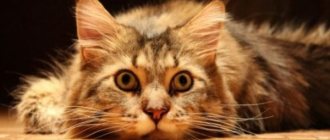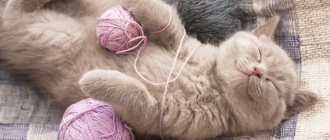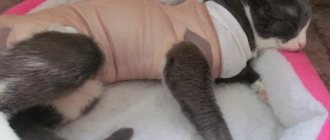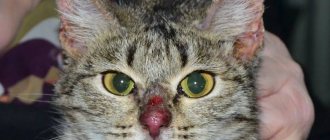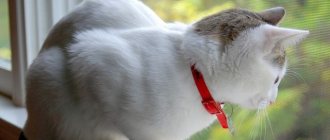Unusual item
Most experts are unanimous - it is not the cucumber itself that causes fear in an animal, but an object that appeared unexpectedly and clearly does not belong there. Jill Goldman, an animal behaviorist, explains that such a reaction can be caused by any unusual object - a hose, a mask, a toy, an eggplant.
Cats are naturally very cautious animals and prefer to assess danger from afar.
An unusual object that suddenly appears is perceived as potentially dangerous, so the cat strives to move away to a safe distance as quickly as possible in order to calmly observe the object from there.
Russian cats are not afraid of cucumbers: truth or myth
Among the cat owners there were those who could not resist and subjected their pets to the cucumber test . The results of such experiments showed that not all cats are afraid of cucumbers. There are also animals that are not only indifferent to these vegetables, but also show interest in them, play with them, drag them around the apartment from corner to corner.
The findings suggest that the videos that caused a stir on the Internet may have just been successful pranks. And since the majority of cat owners who confirmed that their pets had no fear of cucumbers were residents of Russia, another interesting statement arose that Russian cats are not afraid of such a vegetable as a cucumber.
Undoubtedly, this opinion would flatter animals from Russia, but it is wrong. In fact, among the Russian representatives of the cat family there are those who experience a fear of cucumbers as strongly as their foreign counterparts. The attitude towards a cucumber is caused by the temperament of the four-legged friend, and not by his nationality or place of residence.
Since the cause of fear is hidden in the animal’s subconscious instinct, this means that any cat can be afraid of a cucumber, regardless of breed and other conditions. And if a Russian, American, or English cat was not afraid of this vegetable, and even became interested in it, then this does not indicate the uniqueness of the animal. Everything explains the cat’s character, expressed by his actions, obedience, and emotions.
Some cats are aggressive towards surprises, others want to study an unknown subject, and still others will even decide to just eat a green vegetable. In fact, the assumption that Russian cats are not afraid of cucumbers is a myth.
Some cats are quite tolerant of cucumbers, play with them and even taste them.
Suddenness of appearance
Research by animal psychologist John Bradshaw, author of the book “Cat Feelings,” explains why domestic cats have much stronger wild instincts than domestic dogs. It is their natural instincts that make them wary of unusual objects that appear in their “blind spot.”
The opinion of the animal psychologist is shared by another anthropopsychologist, Dr. Roger Manfred. He points out that for a successful “draw” certain conditions must be met:
- the cucumber must be long-fruited;
- you need to put it down very quietly and carefully;
- the vegetable is located behind the animal so that it does not see it ahead of time;
- The cat should be focused on food.
Each of these conditions is itself an explanation for fear. A snake-like object suddenly appears in an area that is difficult for the cat to control.
Causes of fear
Veterinarians, cat breeders and other “cat” experts have identified several reasons why a cat experiences fear when an ordinary cucumber appears in its field of vision.
Cucumber is a new item for the cat
Cats are usually suspicious in order to be able to quickly protect themselves in case of danger. This is the main reason for their fear of cucumber. The animal's violent reaction to this object suggests that cats do not like the effect of surprise.
They are used to being in control of everything that happens around them. The problem of a cat's fear, in essence, does not lie in the cucumber itself; it is broader in scale, since the animal is afraid not so much of this vegetable as of all other unknown objects that suddenly appear on its territory.
The cat is frightened by new objects and is wary of them.
Some curious cat owners decided to check how their pets react to other oblong objects. The animals were given curling irons, zucchini, and bananas. If they appeared in the cat’s field of vision suddenly, like a cucumber, then the result was the same: the animal was afraid of them.
The cat considers the cucumber a threat
The fear associated with the appearance of a cucumber is not a phobia, it is an adequate reaction of the body (an existing instinct) in response to sudden external stimuli, a possible threat or danger.
This reaction of the animal is called the start reflex, during which the cat jumps away, and from there it evaluates the current situation and the likelihood of a threat. A simple cucumber may look like a snake or other natural threat to an animal.
The cat considers the cucumber a threat
While eating, the animal's vigilance is weakened
The place where the cat eats is considered the safest by him. While eating, the cat's entire attention is absorbed in food, his vigilance is weakened. He doesn't wait for a threat. Therefore, a cat’s protective reflex can react to both a cucumber and any other object that appears unexpectedly.
Another possible reason is the cat’s psychological trauma. It is possible that the cucumber was previously used to intimidate the animal, which is why now it is so afraid of it.
Shy nature of the animal
Fear of cucumbers can arise due to the nature of the animal itself. He has increased nervousness, heightened sensitivity to everything that happens, and an unbalanced character. In this case, the pet will be frightened by the sudden appearance of a cucumber and other factors.
The fear of cucumber is associated with the timid nature of the cat.
Invasion of the comfort zone
In addition to the effect of surprise, which can unbalance even a person, and novelty (cats are inveterate conservatives and cannot stand surprises), a frightening object appears in the area that the animal considers:
- safe;
- only yours.
A cat's territory is divided into comfort zones in which it feels safe. These are shelters or hills that are difficult for other inhabitants to climb, but convenient for the cat to observe movements. That's why pets love cabinets, hangers or boxes so much.
During sleep, bowel movements and eating, the animal is least protected, so the cat may behave aggressively or become frightened if someone or something invades this territory. An animal that is keen on eating food does not expect any trick from its beloved owner, next to whom it feels comfortable and safe.
The fact that cats feel safe next to their owner is confirmed by frequent cases when the animal brings caught prey to the doorstep of the house or directly to a person’s bed. Scientists believe that cats do this not because they want to feed a person, but so that they can then eat the prey in the safest possible place.
Where does the idea that cats are afraid of cucumbers come from?
In the summer of 2015, with the help of a video posted on the website of one of the popular publications, a cat’s fear of green vegetables was clearly demonstrated to the world for the first time. And although such an experiment is hardly humane, many people began to repeat the same trick with their four-legged pets. In this case, people see the reaction of cats as extremely funny and do not think about the reason for such fear, about what the cat himself is experiencing at this time.
Video: cats' reaction to cucumbers
The joke about a cat's reaction to a cucumber is that when the animal eats, it doesn't feel threatened. He is surrounded by familiar objects, delicious food, and a master whom he loves. The cat does not expect a trick and experiences real panic when suddenly a long green object appears from behind him from nowhere. The cat panics.
Seeing a cucumber near him while eating, the cat jumps out of fear and surprise
Stress and health
The cat's reaction of "fun" in those whom she considers to be a member of her pride and often equates to her mother cat is dangerous because it can provoke stress. The state of stress does not go away without a trace, Hans Selye, an Austrian scientist who made an invaluable contribution to the study of painful adaptation (stress), spoke about this.
Research. Lydia Rendberg, an employee of La Trobe University in Melbourne (Australia), is studying the effects of stress in cats. She warns: “Cats are sensitive creatures and react to little things around them.” Fear, loss of a sense of security, and a sense of betrayal create stress, which negatively affects the physical and mental health of the cat.
Stress causes:
- heart diseases;
- diabetes;
- obesity;
- thyroid diseases;
- pathologies of the spine and joints;
- cancer;
- pathologies of the respiratory system;
- eczema;
- mental and behavioral disorders.
Scientists believe that stress is to blame for 86% of diseases.
Therefore, animal psychologists and veterinarians appeal from the pages of magazines, newspapers and in videos to cat owners with a request to stop cruel and immoral experiments on their pets.
Also watch the video why cats are afraid of cucumbers:
Consequences
The stream of videos never stops: curiosity outweighs love for a pet and pushes people to new experiments. At the same time, veterinarians ask owners to stop injuring their pets. Sudden movements sometimes end in bruises: cats hit surrounding objects and fall unsuccessfully.
Every fright becomes a nervous shock, constant experiments negatively affect health, appearance, behavior:
- the pet does not want to go to the bowl, eats worse, does not receive enough nutrients;
- diseases of the gastrointestinal tract develop;
- digestion is upset;
- wool sheds more abundantly;
- the functioning of the urinary organs is disrupted;
- immunity weakens;
- anxiety increases, causing the animal to panic;
- sleep patterns are disrupted.
Why are cats afraid of water?
How to determine the sex of a kitten
How to clean a cat's ears at home
After a series of experiments, the cat loses trust in people. Instead of a calm, friendly pet, the owners get an aggressive, apathetic, withdrawn cat. It is difficult to return to their previous behavior; nervous individuals lose consciousness from fear and suffer a heart attack.
I’ll probably check my cat too...
Animal advocates strongly advise against testing your cats for cucumber phobia.
Remember, that:
- firstly, the likelihood of physical injury to the animal increases (a cat can crash into a table, cabinet or other object in the apartment and get hurt).
- secondly, after experiencing stress, a cat may develop pathological anxiety, fear, and psychological problems.
Take care of your pets and don’t let them be afraid of cucumbers!
Whatever, let them not be afraid of anything and bring you only joy every day!
Psychological characteristics of the animal
A cat’s fear of cucumbers can also be explained by the peculiarities of its psychology. Of course, animals, like people, can be in different emotional states. The reaction of an animal, which in itself is very restless and anxious, and sometimes it is not even clear for what reasons it shows aggression, will be revealed in the form of such panic fear.
And another reasonable explanation is that when the pet was constantly intimidated with a cucumber or even beaten with it, then the cat, of course, will tremble at the sight of such a vegetable.
Psychology of cats, according to experts
Despite the relative harmlessness of this phenomenon, specialists in the study of animal behavior also managed to react to it, and they were quite able to give an unambiguous answer to this. For example, Jill Goldman explains this reaction precisely by subconscious reflexes. The main feature and strength of cats is their elasticity and speed, which allows them to defend themselves from other animals by choosing the most convenient positions for themselves.
That is why, without identifying the object in the first seconds, the pet quickly runs away from it on reflexes, studying it from afar and drawing conclusions. If an object or potential creature is safe, the cat will certainly approach it after some time. As a rule, she tries to recognize it by regular sniffing, and if the animal still finds it dangerous, it will run away again (this time completely).
Pat Johnson-Bennett, who gained some fame thanks to his own book “Think Like a Cat,” volunteered to complement this answer. In his words, he emphasized the idea that the cat very carefully selects “safe places” for itself. As a result, this can be seen in her attempts to find a comfortable position for sleeping, eating and resting in general (this is where her love for boxes originates, since in the eyes of the animal they seem safe).
Owners of naughty pets may notice this phenomenon when the cat “steals” the owner’s food. He will not eat it right on the spot, but will drag it to the nearest safe place, even if it does not always turn out to be such. While eating, the cat relaxes, she slightly stops monitoring absolutely every detail of her surroundings, as she is confident that this is an absolutely safe place for her! But when the same cucumber suddenly appears nearby, the pet gets scared, because it simply did not notice its approach, knowing full well that it was completely defenseless!
This is the main reason and mystery of this phenomenon, because every animal has a similar protective mechanism. So, for example, in a person’s understanding, home is his safe place, where he knows every corner and definitely does not expect any tricks. But what if, while watching a series on TV, you turn around and notice that the closet has changed its position? You may not run away like a cat (maybe), but the feeling of anxiety will definitely be palpable.
Cucumber resembles a snake
There are several theories, but no definitive answer. Most experts express the opinion that it is not the cucumber itself that causes fear. One of the most popular explanations is that these vegetables remind cats of snakes.
"The instinct to protect cats from snakes is too strong at the genetic level," Con Slobodchikov, a behaviorist and author of Learning the Language of Animals, told ABC News. “Cucumbers are very similar to snakes, and the instinct of the animal awakens.”
Is it possible to fight fear?
To avoid harm to the cat's mental health, the pet owner should try in a calm environment to help his pet overcome his fear of cucumbers. To do this, you don’t need to suddenly take them out. You need to put the cat on your lap, pet him, show him this green vegetable. You should calmly talk to the animal, let it smell the cucumber, play with it, bite it, taste it.
In a calm environment, a cucumber will not cause a feeling of fear in a cat.
When the cat becomes familiar with this vegetable, he will no longer be afraid of it and will not experience stress from its unexpected appearance. On the contrary, such familiarity with the subject has a positive effect on the animal’s psyche. It is important not to force the cat to perform any actions when introducing it to a cucumber. If he is afraid and does not want to approach the vegetable, you just need to leave it on the floor. Perhaps, over time, the cat itself will become interested in the object that initially caused its fear, and will want to get to know it.
If your pet continues to be afraid of a cucumber, you should limit its ability to see this vegetable.
What are the causes of fear of cucumbers in cats?
Scientists were able to establish the exact reasons why cats reacted so violently to the appearance of a completely harmless green vegetable in their field of vision.
A cucumber is a completely new item for a cat.
Cats like to be in control, and they don't like it at all when some strange object appears on their territory. Any surprise can cause fear in an animal, which is why the pet reacts so violently to a cucumber, which, in its opinion, appeared literally out of nowhere. So in this case, cucumbers have nothing to do with it. Even if you put any other oblong object instead of a green vegetable, then most likely the cat will be scared of him too.
The cat perceives the cucumber as a threat
Cats always jump away sharply when they notice some kind of danger. This is a normal reaction of the body, called the start reflex. Animals prefer to first be as far as possible from the object that causes them fear, and only then evaluate the current situation. So an ordinary cucumber may well seem like a snake or any other dangerous creature to a cat.
Why cucumber?
As was said, the cat is always suspicious of everything new, and the most common cucumber is no exception. As a rule, such an animal strives to run away from anything that could be dangerous. Therefore, if it was not possible to recognize an object within a few seconds, this causes fear in the pet’s psychology. The reason is very simple and it lies in the characteristics of such an “insidious” vegetable:
- It is difficult for cats to recognize a cucumber as a harmless object because of its shape (in the animal’s understanding, it may well be a lizard);
- The cucumber is green, which can also be additional evidence that it is something living (the same lizard or toad);
- The cat will only get scared if you add a cucumber unnoticed! But where did this “thing” come from in front of his nose? This is very suspicious...
- It may well seem to the cat that the cucumber is moving (fidgeting), because without noticing it at first, the animal may step on it! The vegetable, of course, will twist slightly, which can be regarded by the pet as a full-fledged movement and a sign of “aggression” from an unidentified object.
Experiment No. 1
The pet is sitting on the window. We approach him and take a cucumber out of the bag. I put it in front of him. What will the animal's reaction be? From indifference to frisky, cheerful play with the object of the experiment. Some of these pets even begin to eat the “frightening” vegetable, not without appetite.
The conclusion suggests itself. You can scare cats with this vegetable only in certain situations. Therefore, we are not talking about a natural phobia of pets towards these vegetables. So they are only afraid sometimes?
Let us set ourselves the task of simulating a situation in which a cat would still be afraid of this object.
To do this, we will conduct a second experiment.
How to scare your cat with a cucumber?
If you have such a pet, then you have definitely observed more than once how he is afraid of something. Most often these are certain household items or situations, so there will definitely not be any particular difficulties with this task. The main thing is to place the vegetable near the cat unnoticed, and then observe its reaction. In almost 80% of cases, he will get scared and run away, but, it is important to note, he will certainly remember this. As a result, the cat will not overcome such fear, even if it eats with extra caution.



